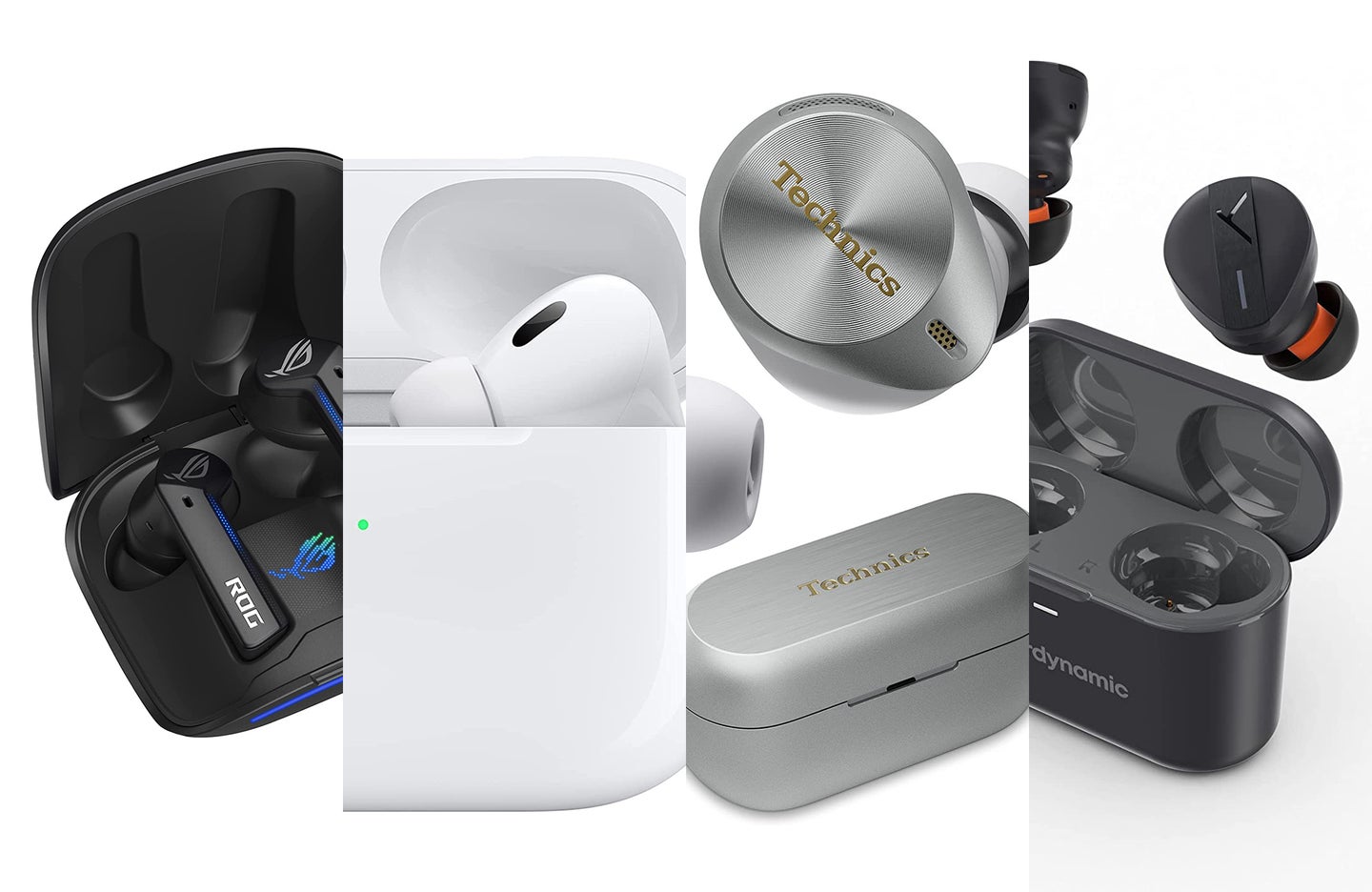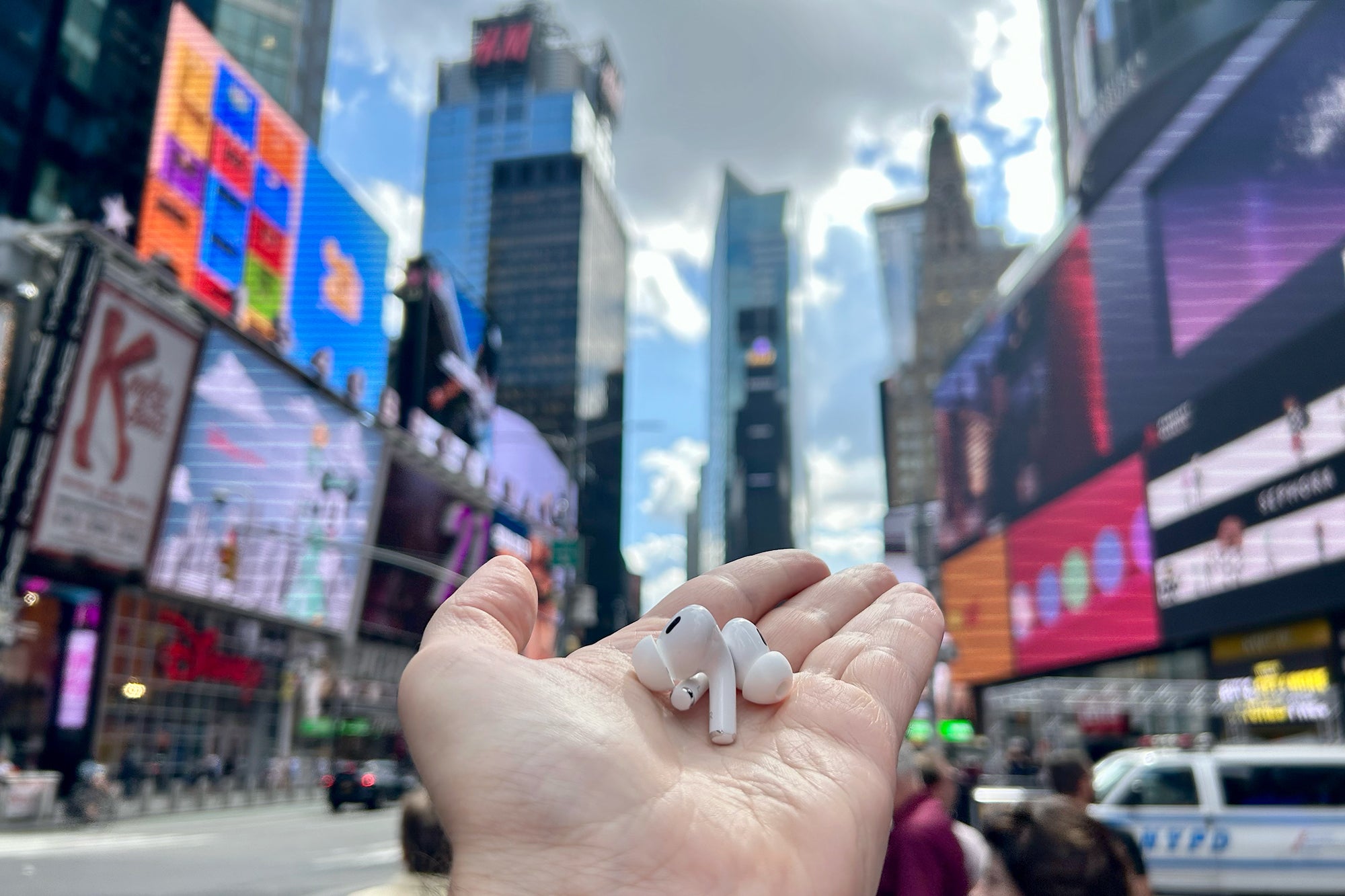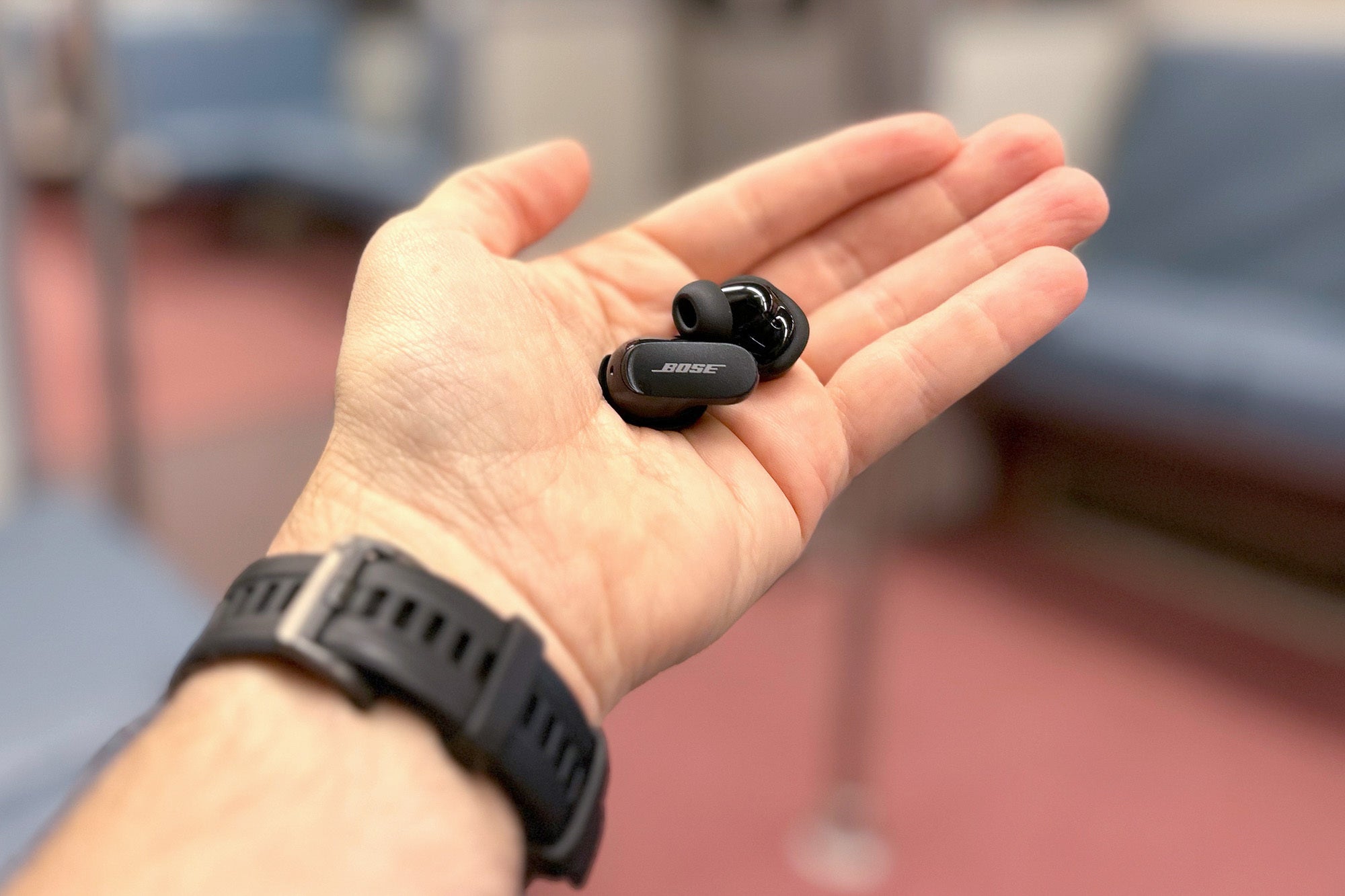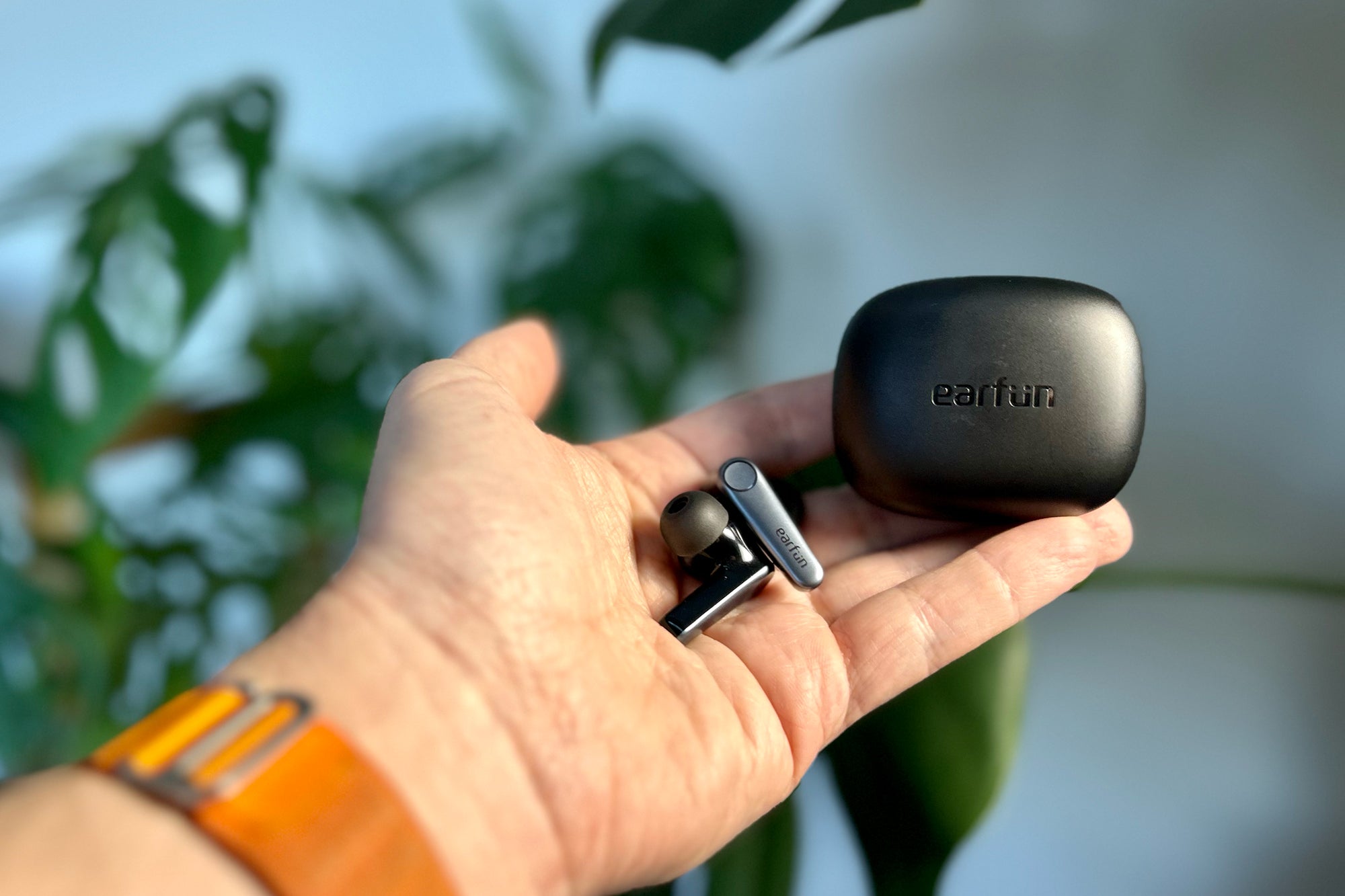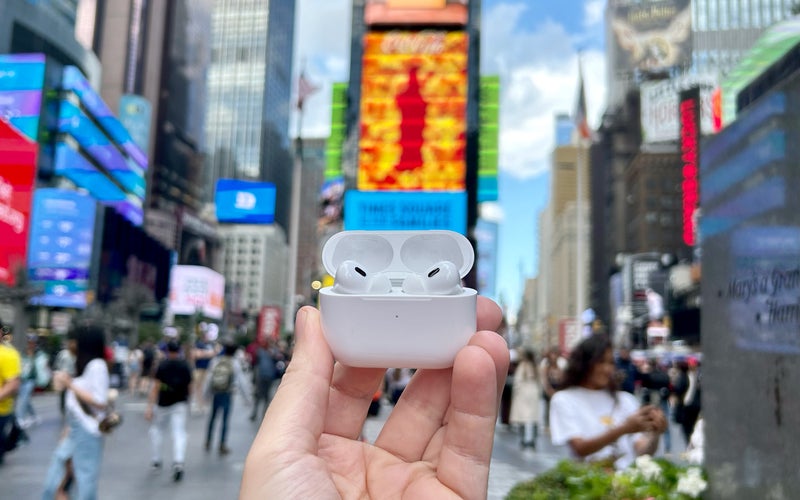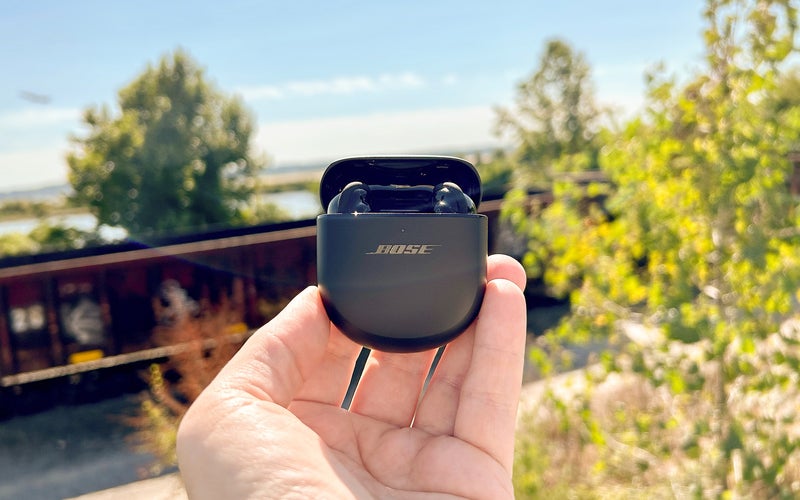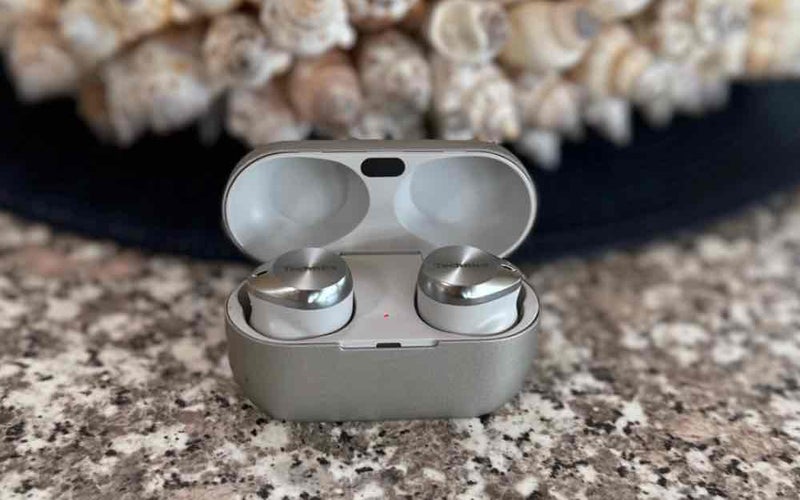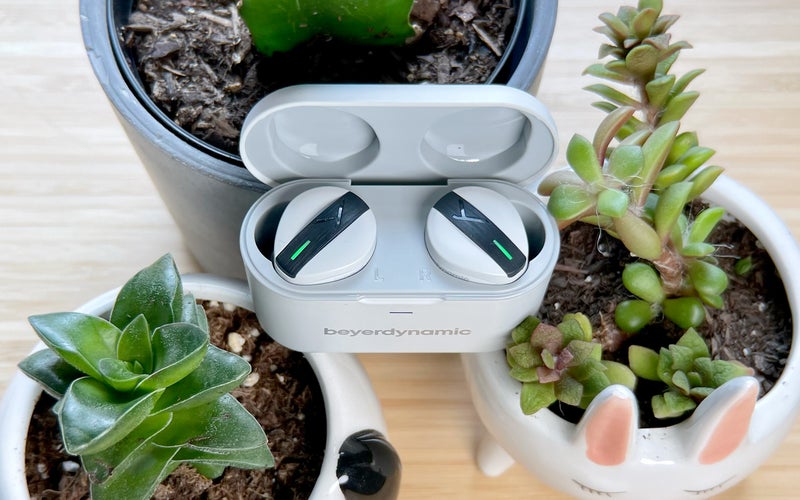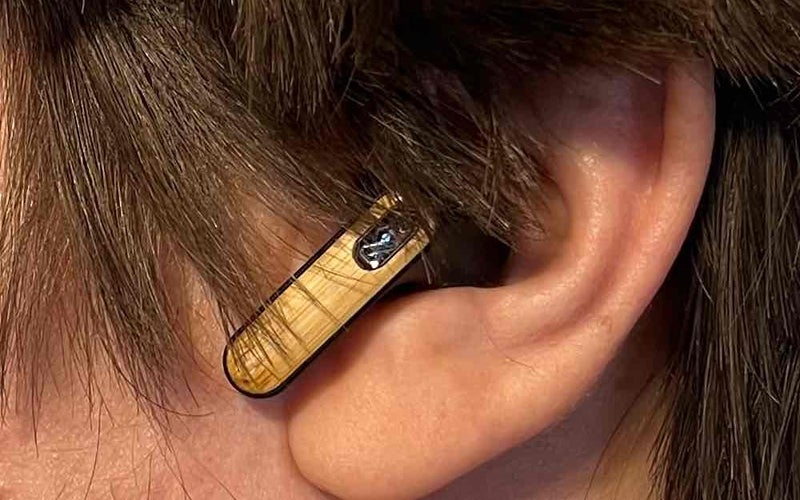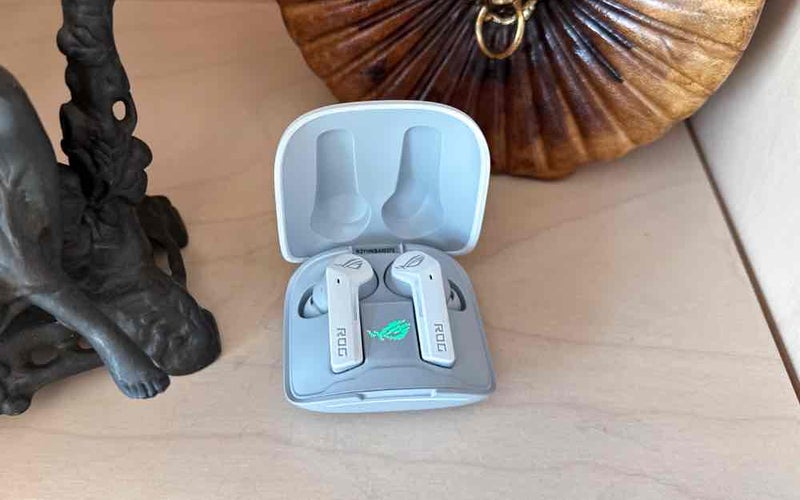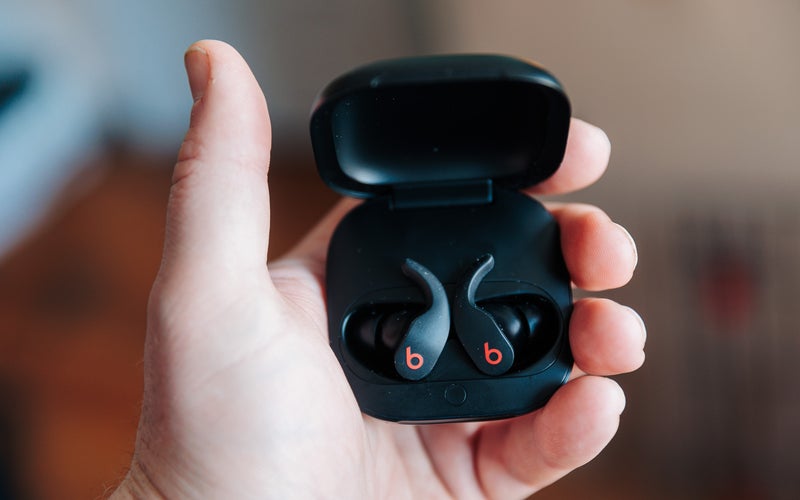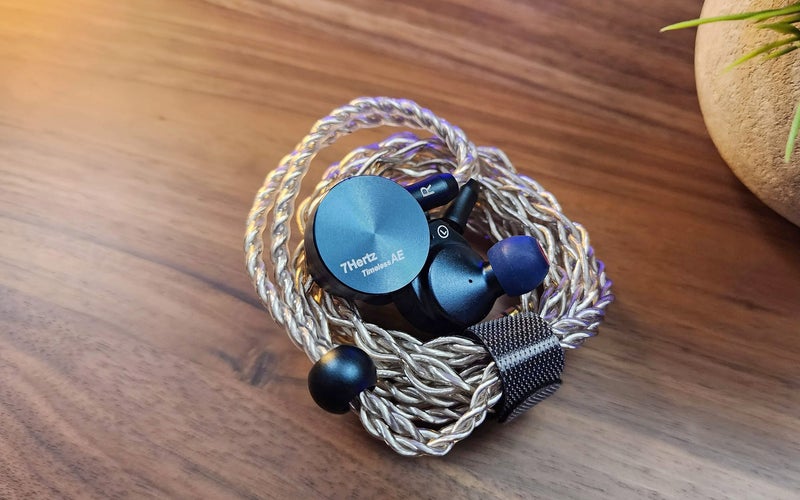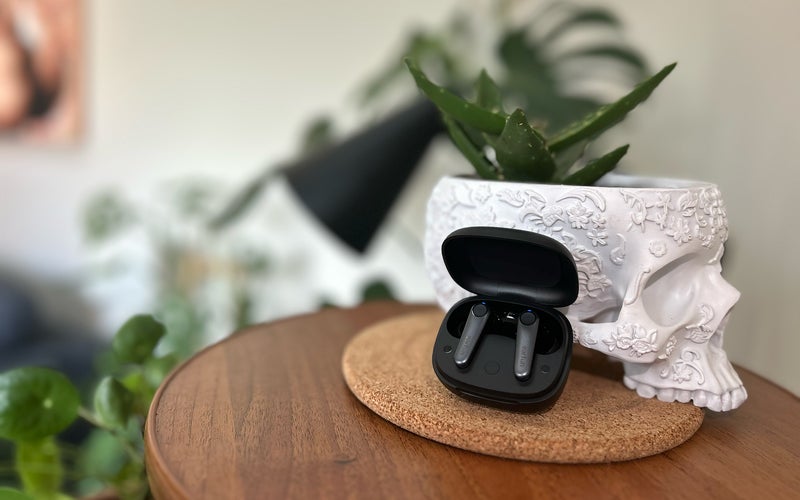We may earn revenue from the products available on this page and participate in affiliate programs. Learn more ›
If you’re wondering just how broad the personal audio market has become, consider the vast world of earbuds, ranging from less than $25 to well over $1,000. While wired earbuds still exist, True Wireless (TWS) earbuds have become the most popular option, thanks to improvements in micro-sized receivers that can deliver huge sound. Bluetooth technology has evolved to the point it can all but guarantee seamless connections, while an array of microphones and sensors help keep music and conversations clear. That means TWS earbuds are no longer a luxury item made by a select few companies. Yet there are still times when a wire is the way to go. Whether you’re an audiophile or a devout Apple enthusiast in the market for sports or gaming earbuds, we’ve compiled what you need to know to find the best earbuds that’ll match your needs.
- Best overall: Apple AirPods Pro 2
- Best noise-cancelling: Bose QuietComfort Earbuds II
- Best for multiple devices: Technics EAH-AZ80
- Best battery life: beyerdynamic Free BYRD
- Best for sustainability: House of Marley Redemption ANC 2
- Best for gamers: ASUS ROG Cetra
- Best for working out: Apple Beats Fit Pro
- Best planar-magnetic earphones: 7Hz Timeless AE
- Best budget: EarFun Air Pro 3
How we chose the best earbuds
There are nearly infinite earbuds available—models of all shapes, sizes, and price points—so we relied on hands ears-on testing to determine the best ones currently available. Our tests helped us determine the best earbuds for several specific use cases, like gaming or podcast listening, and let us single out pairs that performed best when using key features like active noise cancellation. Audio quality was paramount when making our selections, so each earbud you see below passes our sound quality tests regardless of how much money you spend.
The most discerning listeners will be able to pick up the subtle improvements on more premium pairs, but each set of earbuds will sound great if you open up a streaming app, find the music you’re looking for, and hit play. Our focus has mostly been on TWS types, which have become the dominant style in recent years, popularized in the mainstream by Apple’s AirPods. The convenience of these earbuds is undeniable, and current-generation pairs from well-known audio companies and newcomers alike offer incredible sound for their size. But we threw in some other options, too. There’s no shortage of new and exciting earbuds, but these are the best ones you can get today.
The best earbuds: Reviews & Recommendations
Whether you’re heading out for a trail run, on an open-world quest, or need to get locked in a work groove, you can get a pair of earbuds to suit your needs. And you can find them below, where we’ve collected some of the best options for any purpose and across every price point.
Best overall: Apple AirPods Pro 2
Tony Ware
Specs
- Style: True wireless
- Battery life: Up to 6 hours
- Active noise cancellation: Yes
- IP rating: IPX4
- Microphones: Yes (3)
Pros
- Well-balanced sound
- Solid battery life
- Compatible with Spatial Audio
- Updated case with “Find My” support
Cons
- Best technical features only work when connected to Apple devices
Apple’s second-generation AirPods Pro—colloquially known as AirPods Pro 2—are the best earbuds you can get in 2023; there, we said it. The latest version of Apple’s true wireless earbuds feature appreciable improvements in audio quality, active noise-cancelling performance, Spatial Audio support, and they come in an updated case with genuinely useful features. In short, it’s the total package, and it should be the default choice for many, especially if you use Apple devices.
In our first impressions, and continued tests conducted over several months of frequent use, the AirPods Pro 2 consistently impressed. The earbuds don’t have a totally flat frequency response, but Apple’s sonic sculpting—a little extra boost to the bottom end and slightly raised mids—doesn’t make songs sound unnatural or artificial. Music with a lot of low-end sounds extra full without bass distortion, while live music, pop, rock, and jazz benefit from Apple’s tweaks. We never found ourselves wanting to muck around with a digital multiband EQ. Apple did the research to determine what would sound good to most people, and it mostly stuck the landing.
The original AirPods Pro earbuds were lauded for bringing premium active noise cancellation to earbuds, and the second generation brings several improvements in this area. The AirPods Pro 2 could block out far more ambient noise—keys being typed, birds chirpings, footsteps—and loud sporadic noises like a New York City subway car clattering on the tracks. It’s not the best active noise cancellation we’ve experienced in a pair of earbuds, but it’s not too far off.
Apple says the AirPods Pro 2 earbuds get up to six hours of playtime per charge, with an extra 24 hours thanks to its battery case. That’s mostly been true in our experience, though keeping active noise cancellation enabled all the time did drain the earbuds more quickly. With one or two 15-minute breaks, you should be able to get through an entire international flight with the AirPods Pro 2’s ANC turned on. If you work in an office, coffee shop, or at home with another people, the active noise cancellation should be sufficient to create a reasonable buffer between you and the outside world.
One of the big bets with the original AirPods was support for Spatial Audio, a type of binaural surround sound you can take on the go. The technology was impressive, if unproven, but Apple has spent the past few years coaxing artists to re-release classic albums or release new ones with a Dolby Atmos mix. The library for surround sound music on Apple Music has exploded, and the AirPods 2 let you take full advantage of it—though if you want the true Dolby Atmos experience, you’ll need to pony up for an Apple TV and surround sound speaker system.
Spatial Audio tracks on the AirPods 2 do sound more immersive than their stereo counterparts, especially if you enable head tracking, which will automatically pan music based on how your head is turned to recreate the experience of listening to music on speakers. Spatial Audio mixes are still hit or miss, but at least there’s a variety of music to choose from. Apple offers a way to personalize the Spatial Audio experience by taking pictures of your face and ears, but we didn’t notice a big difference and performance.
One of Apple’s most unexpected updates to the AirPods Pro 2 was changing its case. The new case has a larger battery, lanyard loupe, and support for “Find My,” which allows you to track the location of your AirPods 2 case in case the earbuds get lost. A built-in speaker can play a chime, making it easier to find. These welcome improvements make a tangible difference in the earbuds’ overall usability. Sometimes it boils down to nice things being nice.
The only potential downside to using the AirPods Pro 2 is that they’re designed to work best with Apple’s other gear, so if you don’t have an iPhone, iPad, or Mac, you’ll get a slightly worse experience. The AirPods Pro 2 will still sound the same and have identical active noise-cancelling performance, but features like instant pairing are absent. This isn’t a dealbreaker, but it’s something to consider if you live in the Windows and Android world.
Are the AirPods Pro 2 the best-sounding earbuds? No. Are they the best active noise-cancelling earbuds? No, but by offering a great technical and audio experience, they’re the most well-rounded pair. The whole is greater than the sum of its parts, and we can’t imagine anyone complaining about this pair of earbuds.
Best noise-cancelling: Bose QuietComfort Earbuds II
Tony Ware
Why it made the cut: Bose’s QuietComfort Earbuds II have the most-efficient noise cancellation of any earbuds we’ve ever tested—to an almost eerie extent.
Specs
- Style: True wireless
- Battery life: Up to 6 hours
- Active noise cancellation: Yes
- IP rating: IPX7
- Microphones: Yes (4)
Pros
- Best-in-class noise cancellation
- Four microphones per bud
- Bose app is actually helpful
Cons
- Only three pairs of eartips are included
Bose’s QuietComfort Earbuds II are actually kind of scary. Their active noise cancellation was so effective that sounds I used to test it, like clapping my hands, didn’t produce an audible sound. The difference between what I was seeing and hearing was actually jarring. At some points, the only thing I could hear and feel was my heartbeat, a unique experience compared to my experience with other ANC earbuds. I’m not alone; our associate managing editor was also impressed while commuting with them on the New York City subway.
The reason for this incredible active noise cancellation? Each bud has two microphones instead of one. The mics are located above and below each bud’s ear tip, which also improves your vocal quality while taking calls. This hardware is tightly integrated with Bose’s custom processor, which continually adjusts to filter frequencies with laser precision. This performance comes in a pair of earbuds that’s roughly a third smaller by volume compared to the first-generation pair and comes in a dramatically smaller case.
If you don’t want to experience the full isolation chamber-like experience the QuietComfort Earbuds II can offer, you can adjust their active noise cancellation via Bose’s mobile app, which is better than you’d expect. The app walked us through the earbud’s initial pairing process and made it easy to switch between quiet and aware—noise cancellation and transparency modes, respectively—and allowed us to set two custom modes based on our personal preferences. We opted to create a “home” mode with active noise cancellation at 100%, allowing us to experience the earbuds’ true potential.
On the audio side, Bose updated the QuietComfort Earbuds II with 9mm dynamic drivers and Bluetooth 5.3 with support for the SBC/AAC codecs. We liked how the earbuds’ sounded out of the box and didn’t need to futz around with the digital EQ in Bose’s app—though we were pleased it was present. We could hear each instrument in complex arrangements, even while listening to lossy audio with ANC on. Subtle sounds—like the piano on “Smog Eyes” by Warne Marsh— were as present as prominent ones, a true feat. The earbuds could have heavy-handed treble on occasion, but that had to do with how certain tracks were mastered rather than a technical deficiency on the earbuds themselves.
There’s no shortage of excellent active noise-cancelling earbuds, but the Bose QuietComfort Earbuds II currently reign supreme.
Best for multiple devices: Technics EAH-AZ80
Brandt Ranj / Popular Science
Specs
- Style: True wireless
- Battery life: Up to 7 hours
- Active noise cancellation: Yes
- IP rating: IPX4
- Microphones: Yes (8)
Pros
- Smooth multi-point pairing
- Four microphones per ear
- Compact size
- LDAC support
Cons
- Cost
Technics may be most synonymous with club turntables thanks to its legendary SL-1200 (now 1210MKII), a deck used worldwide by DJs. Still, music listeners (rather than performers) should immediately acquaint themselves with the company’s new EAH-AZ80 earbuds. Their marquee feature is triple multipoint pairing—the ability to keep the earbuds connected to three devices simultaneously—but that’s just the tip of the iceberg. We’ve had the opportunity to test the earbuds for a couple of weeks, and they’ve become the top pair we’ve tried in 2023.
Let’s start with their multipoint pairing, which works astonishingly well. After pairing the earbuds to a couple of devices, they would automatically connect to both as long as they were within range. If I paused music on the first device, I could hit play on the second, and the audio would immediately start to play. The same was true when I threw a third device into the mix—to be clear, I approach any Bluetooth earbuds multipoint pairing with skepticism, and no earbuds claim to work with three devices. This is very difficult to pull off technically, and the only earbuds that have done it as well are Apple’s AirPods 2. But Apple’s top-tier earbuds only support seamless multipoint pairing when connected to the company’s other devices. The EAH-AZ80s can be multipoint paired with any gear regardless of its operating system.
On the active noise cancellation front, these earbuds stand above the AirPods Pro 2 but not quite at the level of QuietComfort Earbuds II. They blocked out almost—but not quite—as much sound as the latter. Commuters and travelers can turn to Technics earbuds for excellent ANC performance, and it’s up to most of the rest of the audio industry to play catch up. As for how others can hear you through ambient noise, eight high-sensitivity MEMS mics plus advanced noise reduction capture and transmit your voice clearly. Surprisingly, Technics went from off our consumer earbud radar to near the top, but that’s how good the EAH-AZ80s have performed in our tests.
While we were pleased with the earbuds’ technical performance, we were blown away by how good the 10mm free-edge drivers (housed in a custom acoustic chamber) sound. Rich bass, smooth as silk midrange, and clear highs were present each time we hit play. It didn’t matter if we were listening to Miles Davis’ “Kind Of Blue” for the umpteenth time or catching up with the latest Dawes album released earlier this year; the EAH-AZ80s would continue to reveal new sounds during repeated listenings. These are reference-grade Bluetooth earbuds, especially if you’re using one of the few devices that support the LDAC codec (either a small selection of Android smartphones or a dedicated digital audio player), which offers near-lossless audio quality streamed wirelessly. If you have the right setup and audio files, these earbuds are basically peerless.
All of this performance comes at a cost, and while the EAH-AZ80s aren’t the most expensive earbuds out there, they’re a sizable investment. However, if you regularly bounce between different devices, stream high-resolution audio, prefer smaller earbuds, or can appreciate any combination of the three, we can’t see how these earbuds would let you down.
Best battery life: beyerdynamic Free BYRD
Tony Ware
Specs
- Style: True wireless
- Battery life: Up to 11 hours
- Active noise cancellation: Yes
- IP rating: IPX4
- Microphones: Yes (2)
Pros
- Incredible battery life
- Bundled with eight sets of ear tips
- Phenomenal fit
Cons
- They stick out from your ears
Beyerdynamic has been a part of the audio world for decades, impressing us with its mixing headphones, among others, but its latest long-lasting earbuds took us by surprise. While we were pleased by the Free BYRD’s sound and fit, its 11-hour battery life (eight if you leave active noise cancellation off) is in the top tier of true wireless earbuds. If you toggle ANC on and off regularly, you should have no problem getting nine hours of music playback before popping them back into their case. If you do somehow run out of juice during a single listening session, the Free BYRD’s case offers an hour of music playback off a 10-minute charge.
Most true wireless earbuds last roughly five to six hours with ANC turned on—the extra two hours offered by the Free BYRDs make a huge difference on a transatlantic flight, where tuning out the whirring sound of an engine can make the difference between sleep and misery. The Free BYRDs’ battery life is impressive, but it’s not the only reason they’ve made the cut. We were also very taken by the earbuds’ noise cancellation, which only comes up short when compared to the QuietComfort Earbuds II.
While the Free BYRDs didn’t produce the same eerie isolation chamber-like effect as Bose’s earbuds, they did block out a significant amount of noise. When listening to music at 80%, only the loudest sounds—think a sudden, expected clang, or jackhammer on the street—could pierce the bubble. One of the reasons for this impressive performance was that Beyerdynamic includes eight pairs of eartips in the box, so you can find the ones that fit your ears perfectly.
A tight seal around your ear is essential to getting good active noise-cancelling performance, and the Free BYRDs pass that test with flying colors. A tight seal can put unwanted pressure on the inside of your ear, but that was never the case with these earbuds. Another upside: The earbud seal was so tight we could headbang to our heart’s content without the risk of them falling out.
Concerning audio, the Free BYRDs’ 10mm dynamic drivers produced sound on par with our top-rated earbud pick, the AirPods Pro 2. They support SBC, AAC, and aptX Adaptive codecs in their Bluetooth 5.2 container. In our tests, which included listening to music from different genres and spoken word audio like podcasts and audiobooks, the Free BYRDs never skipped a beat. Everything we listened to sounded surprisingly natural, which is particularly great when listening to people speaking.
Punchy bass, midrange clarity, and never-crispy treble are always a winning combination, as they are here. The sound was so good we never thought about mucking with the digital EQ in beyerdynamic’s MIY app. You can run through a hearing test in the app to tune these earbuds based on how sensitive your ears are to different frequencies, but this is entirely optional. We can’t imagine anyone being upset with the way the Free BYRDs sound out of the box.
You should be aware of the guitar pick-like shape of these earbuds, which makes them protrude from your ears. It’s not that you look silly wearing the Free BYRDS, but they will look different than most modern earbuds. That’s a small price to pay for their great sound, solid active noise cancellation, and exceptional battery life.
Best for sustainability: House of Marley Redemption ANC 2
Brandt Ranj
Specs
- Style: True wireless
- Battery life: Up to 6 hours
- Active noise cancellation: Yes
- IP rating: IPX5
- Microphones: Yes (2)
Pros
- Made from sustainable materials
- Fast charging support
- Surprisingly good fit
Cons
- Lackluster app
With the Redemption ANC 2 earbuds, House of Marley has made bedfellows out of technology and sustainability without any major concessions. These earbuds—case and all—are made (in part) from a mix of solid bamboo, natural wood fiber composite, and recycled plastics.
In our tests, choosing these materials didn’t impact the Redemption ANC 2s sound, fit, or noise cancellation performance, which is especially impressive considering their relatively low price. They even beat some of our favorite earbuds in the durability department due to their IPX5 rating, which will protect them from damage by sweat or splashes of water—getting caught running in a rainstorm won’t spell trouble. This feature is especially welcome because the Redemption ANC 2 earbuds’ fit is so good that we can easily recommend them for working out. Running and jumping couldn’t dislodge them from our ears.
Active noise cancellation is the namesake feature of these earbuds, and we were pretty pleased with their performance in this area. They aren’t at the level of our more premium earbud recommendations, but that’s to be expected given their sub-$160 price. The earbuds effectively blocked keyboard typing and footsteps, but loud noises like car horns could still be heard prominently. They may not be the best choice for airplane flights, but the Redemption ANC 2s are perfectly suited for office use.
Our experience with the earbuds’ sound was similarly satisfying. We could detect a difference in clarity when comparing the Redemption ANC 2s directly to the AirPods Pro 2 or QuietComfort Earbuds II, but that didn’t dampen our enjoyment of listening to music. If you get these earbuds, you’re not going to be disappointed by the way they sound unless you veer toward audiophile hardware, in which case the Redemption ANC 2s aren’t targeted at you. There was some muddiness in the low end and some sibilance at the high end, but overall the earbuds produced a pleasing sound. You can mitigate some of these audio abnormalities by tuning the EQ in House of Marley’s app, but we were disappointed by how barebones this software was.
Despite this setback, we feel comfortable recommending the House of Marley ANC 2s to anyone who takes the sustainability of their technology seriously. You’ll end up with a good-sounding, great-fitting set of relatively inexpensive true wireless earbuds with a fair lower environmental impact than most gadgets.
Best for gamers: ASUS ROG Cetra
Brandt Ranj / Popular Science
Specs
- Style: True wireless
- Battery life: Up to 5.5 hours
- Active noise cancellation: Yes (Hybrid)
- IP rating: IPX4
- Microphones: Yes (2)
Pros
- Virtual 7.1 surround sound
- Case has an LED
- Price
Cons
- Not the fullest ANC
- So-so audio quality for music
ASUS’ ROG Cetra is a pair of budget-priced true wireless earbuds with features designed for gamers—provided you use the company’s Armory Crate software. One advantage of the ROG Cetras is that the earbuds fit into a hardware ecosystem. ASUS has desktops, laptops, mobile gaming handhelds, controllers, and these earbuds are designed to fit in. Their case has a pleasing rounded-off shape, and opening it reveals an LED—a trademark of PC gaming rigs.
The earbuds themselves feel comfortable to wear and get solid battery life for a pair that costs under $100. We didn’t find ourselves reaching for a charger more than twice a week during our tests, which is on par with earbuds that cost three times the price. The biggest difference between the ROG Cetras and their premium counterparts is noise cancellation. These earbuds support hybrid noise cancellation, which uses external and internal feedforward/feedback mics but isn’t fully effective at blocking noise. Light background sounds would fade away, but moderately loud ones remained audible.
A big draw for gamers who use ASUS Armoury Crate software is the ability to activate the low-latency gaming mode and use these earbuds to create a virtual 7.1 surround sound environment. The effect wasn’t as impressive as Spatial Audio on the AirPods Pro 2, but we could hear some additional separation when the settings were correct. The experience varied from game to game, and ASUS can’t control the sound mixing of each title, so your experience may vary.
We’re recommending these earbuds to gamers because they were designed with this use case in mind. Chiptune music from older and indie games, or explosions and dialogue from newer ones, sounded pretty good, but the ROG Cetra’s 10mm drivers weren’t tuned for music, which didn’t sound very clear. Nuances we could hear with higher-end earbuds were gone on the Cetras, and it was more difficult to discern sounds across different frequency ranges. If you need a pair of inexpensive earbuds to pair with your portable gaming machines, these are a solid pick, but music lovers should look at our other recommendations.
Best for working out: Apple Beats Fit Pro
Stan Horaczek
Specs
- Style: True wireless
- Battery life: 6 hours single-charge; 24 hours with case
- Active noise cancellation: Yes
- IP rating: IPX4
- Microphones: Yes
Pros
- High-performance active noise canceling in a compact earbud design
- Secure design stays in ear when running or working out
- Compatible with dynamic head tracking on iOS devices
- Includes pocket-sized travel case and three eartip options
Cons
- No wireless charging
- iOS device required for full functionality
- Not protected against water immersion
- No multipoint pairing
We’ve thoroughly reviewed the Apple Beats Fit Pro, and they’re the best for working out thanks to their sound quality, movement-friendly design, and fantastic iOS compatibility. They contain the same proprietary H1 chip found in Apple’s AirPods, enabling near-instantaneous pairing, steady, reliable connections to iOS devices, and battery life optimization. Like AirPods, the Beats Fit Pro earbuds are also fully compatible with iOS head-tracking and Spatial Audio features for simulated surround sound and immersive media listening. Their inclusion of active noise cancellation (ANC) and transparency modes make them equally useful on the road and at the gym. We also love the range of colors these buds come in, particularly their unique skin tone range.
The Beats Fit Pro earbuds are designed to sit securely in your ears using small rubber wings that rest comfortably against your outer ear along with three sets of variously sized ear tips. A quick optional setup step uses the earbuds’ onboard microphones to test your fit for sound leaks. Once your optimal fit is achieved, the Beats Fit Pro can endure almost every exercise imaginable—from running to rowing—without budging. The earbuds’ conveniently pocked-sized charging case brings their total battery life to around 24 hours. While it would be nice to see wireless charging in a product with this price tag, we appreciate that the case is chargeable via USB-C rather than Apple’s proprietary Lightning connector.
If you work out regularly and are an iPhone user, you’d be seriously hard-pressed to find a better in-ear option because of the snug fit, balanced sound, and seamless iOS connectivity. If you’re sold on the Beats features but are looking for an option with earhooks, the Powerbeats Pro earbuds are also a solid choice.
Best planar-magnetic earphones: 7Hertz Timeless AE
Chris Coke
Specs
- Style: Wired
- Type: Closed-back earphones
- Frequency Response: 5Hz – 40kHz
- Impedance: 14.8 ohm
- Sensitivity: 104dB
- Weight: 5.5 grams (each earpiece)
Pros
- Very well-tuned, balanced sound
- Full of detail
- Good bass performance
Cons
- Unusual shape
- Limited soundstage
Unlike dynamic and balanced armature drivers, which comprise most earbuds, planar magnetics feature larger, thinner membranes—contributing to lighting-quick low-distortion transients but often require more voltage to drive. Luckily, the technology has evolved so that planar earphones are no longer expensive unicorns. Still, there has rarely been such a well-tuned option at such an affordable price. The magic of the 7Hertz Timeless AE lies in the tuning of its 14.2mm drivers (powered by double-sided N52 magnet arrays), updated to provide deeper, more impactful bass and smoother treble for hours of easy listening. It’s a warmer sound that delivers an enjoyable amount of detail, combining to make these earphones a well-balanced buy at $249. If you’re into wired earphones and want ones that don’t skimp on the bass, the 7Hz Timeless AE is an impeccable balance of price and performance. The Timeless isn’t perfect, however. It breaks the mold with the divisive, quarter-like shape of its earpieces. You’ll either be ambivalent about the shape or outright hate the shells—there doesn’t seem to be much in between.
And suppose you’ve got $1,500 and want something exclusively yours. In that case, the Campfire Audio Supermoon is an in-ear monitor featuring 14mm, 2-micron-thick planar drivers in solid-body enclosures custom-molded to your ear canals. The bass is textured but controlled, the midrange is dynamic, and the treble is honest (which can be a good or bad thing, depending on the recording). Planar IEMs are really coming into their own.
Best budget: EarFun Air Pro 3
Tony Ware
Specs
- Style: True wireless
- Battery life: Up to 9 hours
- Active noise cancellation: Yes (Hybrid)
- IP rating: IPX5
- Microphones: Yes (6)
Pros
- Bluetooth 5.3—with support for SBC, AAC, aptX adaptive, plus LE Audio & LC3
- Multipoint connectivity
- 45-hour playtime: 9 hours + 36 hours with wireless-compatible charging case
- Delivers insane performance:price ratio
Cons
- ANC, while good, isn’t going to match premium earbuds
- Mics can pick up wind
- Volume can seem low with some devices
- Not going to rival the sonic separation of earbuds that cost 3x as much (but they cost 3x as much)
There’s cheap, and then there’s a bargain, and the two shouldn’t be confused. The EarFun Air Pro 3 is the latter: budget TWS earbuds that pack ridiculous features and value for $79 (less with regular discounts). Stemmed earbuds in the style of their namesake (the AirPods, natch), the Air Pro 3 earbuds feature active noise cancellation, Bluetooth 5.3, six mics, 9 hours of battery life, touch controls, multipoint connections, and more in a classic, comfortable ergonomic form factor. If you like the idea of AirPods but not the price, especially if you want that type of earbuds for an Android device, the Air Pro 3 is a top pick.
Bluetooth 5.3—with support for SBC, AAC, aptX adaptive, plus LE Audio & LC3—delivers a low-power, stable signal to feed the 11mm wool composite dynamic drivers higher-bitrate content. Bass is the standout frequency band, punchy without being paunchy, but its confident strut is nicely balanced by fleshy midrange and bright highs. And QuietSmart 2.0 hybrid active noise cancellation up to 43dB ensures you can enjoy that richly appointed range; it’s not Bose-level ANC but proves more than efficient. Plus, there’s a graphic EQ-enabled app to tweak settings and coax clarity. While imaging isn’t the best, and they’re not the most compact, the EarFun Air Pro 3 earbuds are great if you want to take some fun thump on your commute and they are the budget ANC earbuds to beat, particularly for fans of modern bass-heavy genres.
What to consider when shopping for the best earbuds
From a secure fit to fabulous sound, the best earbuds can provide what you need. Here are the main things to consider when shopping:
How can I ensure a good fit?
TWS earbuds have become so popular, in part, because companies have been able to develop earbuds that won’t fall out. The best wireless earbuds include ear tips (typically sized S, M, and L, but sometimes including middle sizes like SM or ML) that fit snugly and comfortably in the canal of your ear. Some models offer flexible wings or fins that fit the concha and make the earbuds feel locked in place, while others come with hooks or malleable wires that curl over your ear to secure things. Deciding on the best design is a personal choice but, thankfully, many models come with multiple ear tip options—most often a mix of silicone (better for quick insertion/removal) and foam (better for isolation)—to give you a good chance of finding a fit that’s right for your ears.
What if I might get caught in the rain?
The best earbuds offer some water resistance, and you can even find waterproof earbuds. The way to determine how your electronics can cope with environmental intrusions is by checking the Ingress Protection, or IP, rating—two numerals that indicate resistance to liquids and dust. Earbuds can go all the way up to an IP68 rating—meaning they can be fully submerged in over 1 meter of water for up to 30 minutes without damage, and won’t be heard by a tumble into the sand at a beach. If you live in a wet climate or work up a prodigious sweat on the treadmill, look for models with higher water-resistance ratings. But if you just need earbuds that can withstand a little drizzle or a few drops of sweat, an IPX4 rating could suffice. Many charging cases for the best wireless earbuds offer their own amount of water and dust protection. However, some of the best budget wireless earbuds sacrifice that added security to reduce costs.
What if I’m a music-first type?
TWS earbuds can work for audiophiles. The best earbuds have high-resolution receivers, digital audio converters, custom-tuned drivers, and amplifiers that combine to deliver sound replicating the original recording as closely as possible. Look for the newest 5.2 or 5.3 versions of the Bluetooth protocol with support for codecs (the digital format that compresses and transmits the sound) that match your device to your earbuds. Everyone supports SBC, but Apple prefers AAC, Sony promotes LDAC, and Android devices are likelier to support aptX/aptX HD/aptX adaptive/aptX Lossless. And these various formats operate at varying bitrates, from basic to high-resolution, with the top of the scale minimizing the lossy properties of compression.
Additionally, information like frequency response can tell you how well the earbuds reproduce low tones to high notes—20Hz to 20kHz is the baseline from which to expand—while the maximum decibel output tells you its capability. At the end of the day, the surest test is to see how the buds sound in your ears, but some of the best earbuds offer detailed EQ customization that almost ensures they’ll play music tailored to your tastes. And if you’re looking for the purest signal, it’s always going to come wired.
What if I need some peace and quiet?
Almost all earbuds provide some amount of passive noise isolation, which means that they are designed with snug-fitting tips that can mute the outside world. Many of the best earbuds, however, offer active noise cancellation (ANC), which means microphones measure surroundings and speakers emit sound waves to neutralize the ambient noise in your environment—the effect makes listeners feel like they are in a cocoon of silence (though some users report a pressurized sensation). Some high-end earbuds step it up to adaptive noise-canceling, which adapts the noise-canceling algorithm based on the sound levels/types or location, and this is often accompanied by a transparency mode, which lets in (and sometimes amplifies) ambient sound when you want to listen to music but also need to hear external announcements, the traffic coming up behind you, etc.
Yeah, what if I still have devices with a headphone jack?
If you’re an audiophile needing the most full-spectrum sound or a gamer needing the lowest lag, or maybe you’re just traveling and want to plug into the in-flight entertainment, shop for the best wired earbuds. While Bluetooth 5.0 should provide a fairly seamless connection, the only way to entirely eliminate lag or frequency response loss is to plug in—although the best Bluetooth earbuds limit these shortcomings to the point where most users can’t even notice it.
What if I’m taking a lot of calls?
If you want to talk to your helpful virtual assistant or want to handle work calls with your staff, you’ll need earbuds equipped with microphones (and if the earbuds have features including ANC, it’s safe to assume there are mics to spare). Beamforming microphones will focus on your voice rather than the sounds around you, while cheaper microphones may mean your listener will get lost in the chatter if you’re in a busy place. Earbud microphones are typically protected by fabric designed to limit wind noise, but if you have the buds in an amplifying mode rather than a noise-canceling mode, you may find the wind distracting.
What if I need my earbuds to last all day?
Earbuds offer playtimes anywhere from a couple of hours to the length of a workday. Charging cases add additional hours—or even days—of battery life before needing to be plugged back in (typically with a USB-C connection). While average earbud life is anywhere between four and eight hours, recharging them typically takes 1.5 hours to 3.5 hours. And many of the best earbuds offer quick-charging options that let you gain an hour or so of playtime in a tiny fraction of that time.
FAQs
Q: Are cheap wireless earbuds good?
Cheap wireless earbuds can be good, especially if you’re just looking for a pair to pump some tunes on jogs or make your commute more bearable. For less than $50, don’t expect superior audio quality. Still, cheap earbuds can offer surprisingly dynamic and detailed sound, and you should be able to find a pair (even True Wireless earbuds) that will fit comfortably, resist sweat, and even handle phone calls.
Q: What should I look for when buying wireless earbuds?
There’s a lot to look for when buying wireless earbuds; your price point and purpose can go a long way toward determining what features you should prioritize. For example, gaming earbuds must limit latency, while the best wireless earbuds for working out must stay in place and repel moisture. Audiophiles may want to spend more for earbuds with high-end processors and/or analog connections that can deliver exceptionally rich and customizable sound. At the same time, shoppers on a budget may be perfectly happy with a set of cheap wireless earbuds that still manage to provide adequate audio quality.
Q: Why are wireless earbuds so expensive?
By now, the technology has developed enough so that wireless earbuds don’t have to be so expensive. Still, building water-resistant earbuds that stay snugly in place and have tiny 6mm drivers and Bluetooth chips that can convert digital data into rich stereo sound costs money, so many of the best earbuds cost more than $100. But at a certain point, wireless earbuds are so expensive because the market allows companies like Apple to charge a premium. Therefore, you’d be wise to compare features and see what it is that you’re really paying for.
Q: How much do wireless earbuds cost?
The best wireless earbuds can cost anywhere from under $75 to over $300, depending on their features. Premium audio hardware (like specialty drivers and advanced Bluetooth receivers), active noise cancellation, multipoint connectivity, and waterproofing are the main drivers of price.
Final thoughts on the best earbuds
- Best overall: Apple AirPods Pro 2
- Best noise-cancelling: Bose QuietComfort Earbuds II
- Best for multiple devices: Technics EAH-AZ80
- Best battery life: beyerdynamic Free BYRD
- Best for sustainability: House of Marley Redemption ANC 2
- Best for gamers: ASUS ROG Cetra
- Best for working out: Apple Beats Fit Pro
- Best planar-magnetic earphones: 7Hz Timeless AE
- Best budget: EarFun Air Pro 3
In many ways, the best earbuds are earbuds that you don’t even think about. They fit in your ear without coming loose and they deliver a sound quality as good as live music. Still, shopping for the best earbuds leaves you with much to consider. Set your price point and go from there. Then, determining whether you need features like ANC, transparency, low latency, and customizable sound depends on how you plan to use them and the sharpness of your ear. With the array of earbud options available, you can definitely find the best earbuds for you. Here’s to making a sound choice.
Why trust us
Popular Science started writing about technology more than 150 years ago. There was no such thing as “gadget writing” when we published our first issue in 1872, but if there was, our mission to demystify the world of innovation for everyday readers means we would have been all over it. Here in the present, PopSci is fully committed to helping readers navigate the increasingly intimidating array of devices on the market right now.
Our writers and editors have combined decades of experience covering and reviewing consumer electronics. We each have our own obsessive specialties—from high-end audio to video games to cameras and beyond—but when we’re reviewing devices outside of our immediate wheelhouses, we do our best to seek out trustworthy voices and opinions to help guide people to the very best recommendations. We know we don’t know everything, but we’re excited to live through the analysis paralysis that internet shopping can spur so readers don’t have to.
